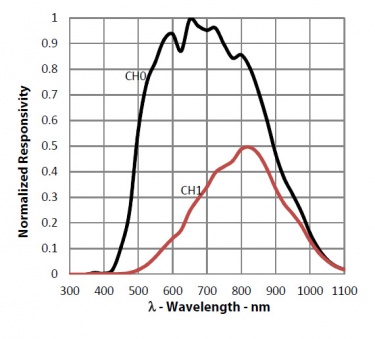LUX1000 User Guide: Difference between revisions
No edit summary |
|||
| Line 9: | Line 9: | ||
Next, you will need to connect the pieces: | Next, you will need to connect the pieces: | ||
[[Image:LUX1000_Functional.jpeg| | |||
[[Image:LUX1000_Functional.jpeg|500px|right|link=]] | |||
# Connect the LUX1000 to the VINT Hub using the Phidget cable. | # Connect the LUX1000 to the VINT Hub using the Phidget cable. | ||
# Connect the VINT Hub to your computer with a USB cable. | # Connect the VINT Hub to your computer with a USB cable. | ||
Revision as of 21:41, 26 June 2017
Getting Started
Welcome to the LUX1000 user guide! In order to get started, make sure you have the following hardware on hand:
- LUX1000 - Light Phidget
- VINT Hub
- Phidget cable
- USB cable and computer
Next, you will need to connect the pieces:
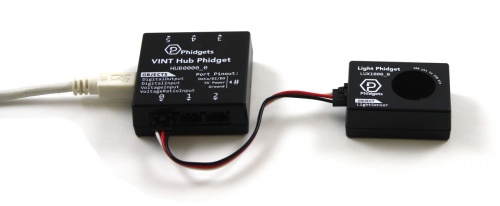
- Connect the LUX1000 to the VINT Hub using the Phidget cable.
- Connect the VINT Hub to your computer with a USB cable.
Now that you have everything together, let's start using the LUX1000!
Using the LUX1000
Phidget Control Panel
In order to demonstrate the functionality of the LUX1000, the Phidget Control Panel running on a Windows machine will be used.
The Phidget Control Panel is available for use on both macOS and Windows machines.
Windows
To open the Phidget Control Panel on Windows, find the ![]() icon in the taskbar. If it is not there, open up the start menu and search for Phidget Control Panel
icon in the taskbar. If it is not there, open up the start menu and search for Phidget Control Panel
macOS
To open the Phidget Control Panel on macOS, open Finder and navigate to the Phidget Control Panel in the Applications list. Double click on the ![]() icon to bring up the Phidget Control Panel.
icon to bring up the Phidget Control Panel.
For more information, take a look at the getting started guide for your operating system:
Linux users can follow the getting started with Linux guide and continue reading here for more information about the LUX1000.
First Look
After plugging the LUX1000 into your computer and opening the Phidget Control Panel, you will see something like this:
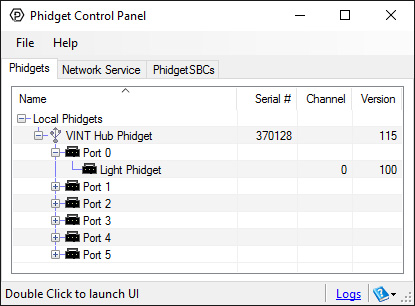
The Phidget Control Panel will list all connected Phidgets and associated objects, as well as the following information:
- Serial number: allows you to differentiate between similar Phidgets.
- Channel: allows you to differentiate between similar objects on a Phidget.
- Version number: corresponds to the firmware version your Phidget is running. If your Phidget is listed in red, your firmware is out of date. Update the firmware by double-clicking the entry.
The Phidget Control Panel can also be used to test your device. Double-clicking on an object will open an example.
Light Sensor
Double-click on the Light Sensor object, labelled Light Phidget, in order to run the example:
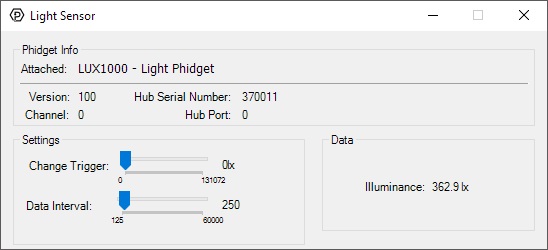
General information about the selected object will be displayed at the top of the window. You can also experiment with the following functionality:
- Modify the change trigger and/or data interval value by dragging the sliders. For more information on these settings, see the data interval/change trigger page.
Technical Details
Current Consumption
Current consumption on the LUX1000 is dependent on the sampling interval you choose. More current is used for frequent samples.
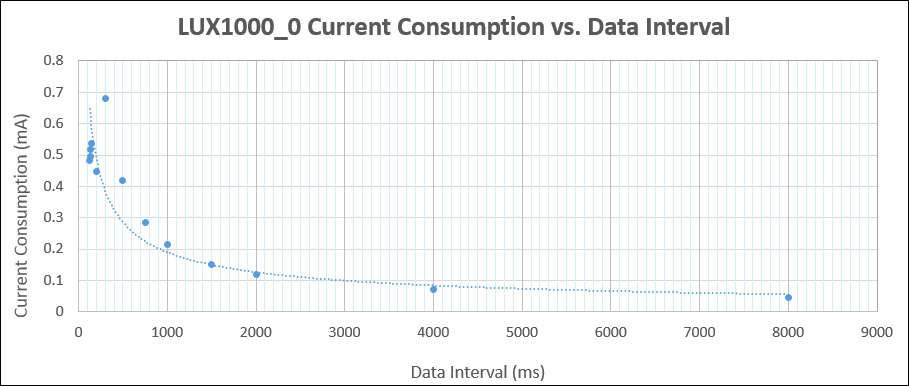
Dynamic Gain and Sampling
The LUX1000 is able to measure the intensity of light in the impressive range of 188µlx to 220klx. It's able to work in such a wide range is due to its ability to dynamically change the gain value on its measurements, in addition to changing the amount of integration time taken per measurement. Changing the gain coarsely affects the range, while changing the integration time finely affects the range
Because of these dynamic ranges, you may see momentary saturation when trying to measure large changes in light intensity in short periods of time (for example, a strobe light). Once the light level stabilizes though, the sensor should be able to settle back into optimal range settings.
Spectral Response
The light sensor on the LUX1000 is designed to sense light in a way that emulates the response of the human eye. However, digital light sensors work very differently than our eyes do. Using the photoelectric effect, the photodiodes in the sensor will generate current when struck by incoming photons. The problem is that the range of wavelengths that these photodiodes respond to vary depending on what materials they're made of, and none of them have the same response as the human eye.
The solution offered by the chip used in the LUX1000 is to take readings from two different photodiodes; one that detects only IR light (which is invisible to the human eye) and one that detects both visible and IR light. Once it has these measurements, it weights them with coefficients based on calibration testing, and then subtracts the IR component from the diode that detects both IR and visible light. The result is a workable approximation of brightness as seen by a human eye.
What to do Next
- Programming Languages - Find your preferred programming language here and learn how to write your own code with Phidgets!
- Phidget Programming Basics - Once you have set up Phidgets to work with your programming environment, we recommend you read our page on to learn the fundamentals of programming with Phidgets.

